Vinca – SADABAHAR
Vinca, commonly known as Sadabahar, scientifically named Catharanthus roseus, is a versatile and attractive plant with numerous qualities that make it a popular choice for gardens and landscapes. Here’s all you need to know about Vinca or Sadabahar plants:
Plant Description:
Vinca belongs to the Apocynaceae family and is native to Madagascar. It is an evergreen perennial with glossy, dark green leaves and vibrant flowers in various colours, including shades of pink, purple, red, and white.
Growth Habit:
Vinca plants have a trailing or spreading growth habit, making them ideal for ground cover or hanging baskets. They can reach about 6 to 18 inches and spread up to 2 feet.
Flowering Period:
Vinca blooms profusely from spring to fall, providing an extended period of colourful flowers. The flowers have a five-petaled, star-shaped form and are known for their durability and long-lasting nature.
Sun and Temperature Requirements:
Vinca plants thrive in full sun to partial shade conditions. They prefer warm temperatures and are tolerant of heat and drought, making them suitable for regions with hot climates.
Soil Requirements:
Vinca plants prefer well-draining soil with a slightly acidic to neutral pH. They can adapt to various soil types, including sandy or loamy soils if the soil is not overly compacted or prone to waterlogging.
Watering Needs:
Vinca plants have moderate water requirements. Regular watering, especially during dry periods, is essential to ensure the soil does not become waterlogged.
Maintenance:
Vinca is a low-maintenance plant that requires minimal care. Deadheading the flowers can promote continuous blooming; occasional pruning can help maintain a compact and tidy appearance.
Uses:
Vinca is commonly used as a ground cover, border plant, or in hanging baskets and containers. Its trailing habit and colourful flowers make it an excellent choice for adding beauty to garden beds, slopes, or cascading from hanging planters.
Benefits:
Vinca plants not only enhance the aesthetic appeal of a garden but also provide several benefits. They are known for attracting butterflies and bees, making them valuable for pollinator-friendly gardens. Vinca’s dense foliage also helps suppress weed growth, making it an effective ground cover option.
Precautions:
While Vinca is generally considered safe, it is important to note that all parts of the plant, including the flowers and leaves, contain alkaloids that can be toxic if ingested. Therefore, keeping Vinca plants out of reach of children and pets is advisable.
Things to know about VINCA
Common (vernacular) Name
विंका (Hindi), Vinca, Sadabahar, Madagascar Periwinkle, Catharanthus Roseus, Nityakalyani, Bara Massi, Bright Eyes, Cape periwinkle, Graveyard Plant, Old maid, Pink Periwinkle, Rose Periwinkle, and many more.
Botanical Name
Catharanthus roseus
Origin
Island of Madagascar
Family
Apocynaceae
Plant Type
Tropical plant
Plant Features
Ornamental / Evergreen / Exotic
Life Cycle
Perennial
Landscape Uses
Container, Walkways, Ground Cover, Mass Planting and Houseplants.
Species
Apricot Cooler Improved, Aztec Pink Magic, Blue Pearl, Cascade Beauty White, Cooler Icy Pink, Cooler Orchid, Cooler Peppermint, Cora Burgundy, Cora Cascade Cherry, Cora Cascade Strawberry, Cora Red, Experimental Dee, Jams and Jellies, Mediterranean Lilac, Mediterranean XP Cherry Halo, Mediterranean XP Rose Halo, Nirvana Pink Blush, Nirvana Red, Nirvana Sky Blue, Nirvana Violet, Pacifica White, Sunshower Lilac, Titian Icy Pink
Varieties
It comes with more than 30 varieties in various leaf and flower colourations.
Size
Height : 1 to 1.5 feet tall and Width : 1 foot wide when mature.
Indoors or Outdoors
Outdoors : Anthurium can be used outdoors in shady plantings; avoid direct sunlight.
Indoors : Excellent plant growth in bright light or indirect light. Best indoor plants for beginners.
Blooming / Flowering
The blooming period is throughout the year.
Flower Colour
It’s come in Pink, White, Purple, Red and Multicoloured.
Lucky Plant
According to Feng Shui, It brings Good Luck in your relationships.
Lighting / Sun Exposure
Bright Indirect Sunlight.
Temperature
Grow best in warm temperatures above 21°C and tolerate max temp. as high as 32°C.
Growth Rate
Anthurium is a slow to moderate grower plant.
Watering
Moderate watering, Mist or overhead sprinkler to provide water and to improve relative humidity. Do not tolerate overwatering, It can cause root damage and leaf yellowing.
Fertilizer
Applying slow-release fertilizer or a water-soluble liquid fertilizer once or twice during the growing season (from spring to summer) is recommended.
i.e., - Cow dung, DAP, Compost, NPK 30-10-10 fertilizer, liquid organic fertilizer etc.
Pruning
Pruning of Anthurium, little is needed. However, trimming away only discoloured or dead leaves.
Propagation
Seeds : The best time to sow your Anthurium seeds is at the end of Winter / early Spring, but it can't give good results.
Stem Cuttings : The easier propagation methods of Anthurium in water or soil via stem cuttings can be done during the warm growing season.
Division : The division of Anthurium can be done in the Rainy season or, better, from February to March.
Dormancy Period
Month : November to February (winter season)
Shed their leaves and show poor growth, Watering minimally.
Avoid : Propagate, Fertilize and Repotting.
Container
Ceramic Pot, Plastic Pot, Terracotta or Clay Pot is preferred, which ensures good drainage and water holding capacity.
Soil Type
A well-drained Loam / Coarse potting soil and water-holding capacity are recommended. Prevent soggy potting medium.
Our recommendation for the potting mix: Equal part mixture of Garden Soil (25%) + Compost (25%) + River Sand (25%) + Cocopeat (25%). You can substitute pieces of Charcoal, Vermicompost, Perlite etc.
Soil pH
Lightly Acidic soil - Ideally, 5.5 to 6.5 pH (potential of hydrogen) is recommended for Anthurium.
Repotting
It is advisable to repot the Anthurium every year or two, preferably during the spring to midsummer season.
Maintenance
Low maintenance and easy to grow.
Properties
The plant poses toxicity risks to both humans and pets if ingested.
Benefits
Excellent indoor air purifier, Anthurium plants turn CO2 into oxygen. It purifies indoor air by removing harmful chemicals like ammonia, toluene, xylene and formaldehyde.
Special Features
It does not attract hummingbirds and pollinators in the same way it does butterflies, bees, or wasps.
Infestation / Pests
Aphids, Scale insects, Thrips, Mealybugs, Spider mites, caterpillars etc.
Diseases / Problem
Physiological Problem : Anthracnose, Leaf Spot and Powdery Mildew.
Bacterial Problem : Bacterial Blight, Bacterial Wilt and Black Nose Disease.
Fungal Problems : Root Rot and Water Mold.
In conclusion, Vinca or Sadabahar plants are prized for their beautiful flowers, easy maintenance, and versatility in various garden settings. With their vibrant colours, heat tolerance, and ability to attract pollinators, they can bring joy and visual interest to any garden or landscape.
Some Glimpse of VINCA

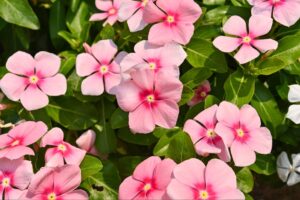
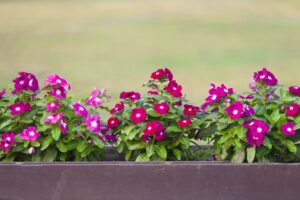
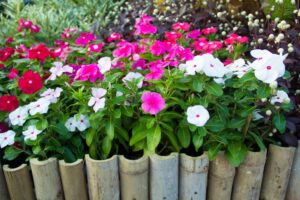
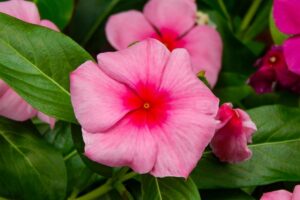
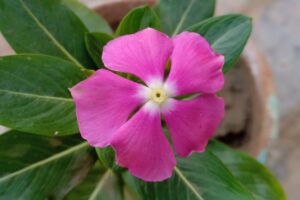
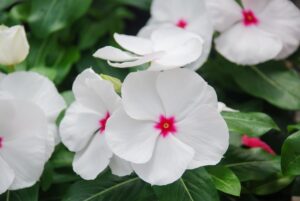

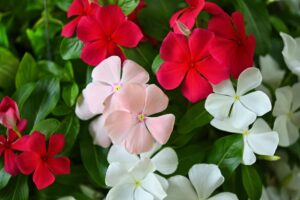
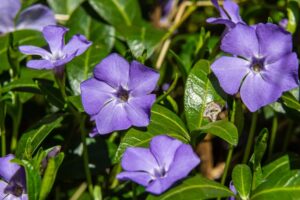
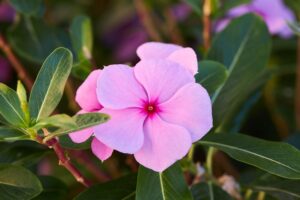
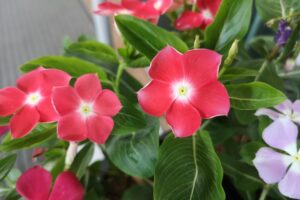


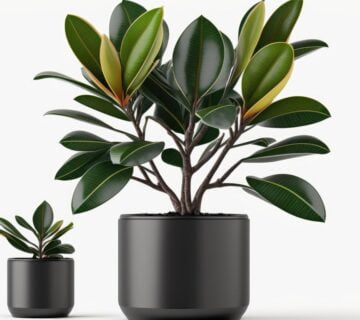
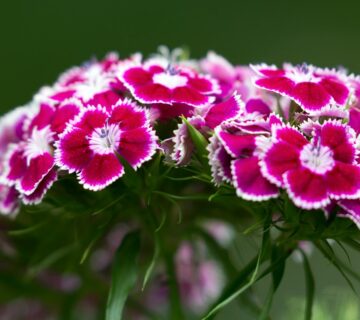
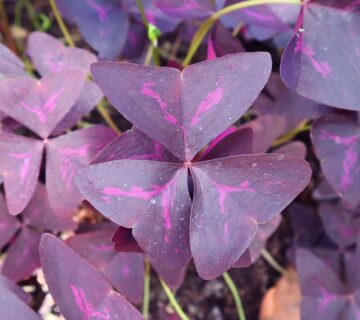
No comment